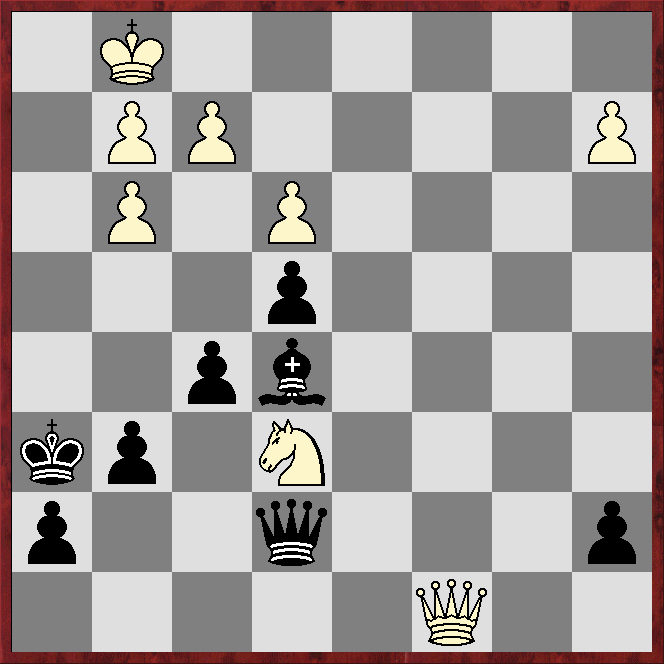New London
1.d4 d5 2.Bf4 e6 3.e3 Bd6 4.Bg3 b6!?
Hinting at, but not committing to, going for an exchange of Black's bad bishop for White's good one.
5.Nf3 Nf6 6.Bd3
*****
*****
*****
*****
6...Bb7
Since White has spent a tempo on moving the light-square bishop, it might be thought this is the time to go for the aforementioned exchange. However 6...Ba6!? 7.Bxa6 Nxa6 7.Qe2 may favour White. My main analysis engines, Stockfish15 and Komodo13.02, suggest continuing 7...Qc8!?, which is not in ChessBase's 2023 Mega database. One line they give continues 8.a3 0-0 9.Nbd2 Qb7!? 10.c4, after which the black queen's knight looks awkwardly placed, but the engines reckon the position is equal.
7.0-0 0-0 8.Nbd2 Ne4 9.c4 Nxg3 10.hxg3
*****
*****
*****
*****
The bishops are a long-term plus and the white kingside is damaged. But Black has no immediate threats and White has hopes of a queenside initiative. Black also has to be wary about a Greek gift sacrifice on h7. Stockfish15's verdict is complete equality, while Komodo13.02 gives White a slight edge.
10...Nd7 11.Rc1 c5!?
The engines agree this is no time to be afraid of possible hanging pawns, ie pawns on d5 and c5 unsupported by pawns on the e or b files.
12.cxd5 exd5 13.b3!?
Preventing ...c4, but there are other ways to do this. The drawback with the move is the white queen can no longer quickly come to the queenside, for example to the a4 square, which means Black can play ...Rc8 without worrying about the safety of the a7 pawn.
13...Rac8 14.Qe2
Not just developing the queen - White wants to get rid of Black's bishop-pair.
14...Qe7 15.Ba6 Bxa6 16.Qxa6 Nf6
*****
*****
*****
*****
The bishop-pair has gone, but in achieving this White has swopped his good light-square bishop for Black's bad one (bad because of a black central pawn being fixed on a light square). In the resulting position Black has more space on the queenside, but White has pressure against the Black queenside. The engines reckon the position is completely equal.
17.Rfe1 Ne4 18.Nxe4 dxe4 19.Nd2
*****
*****
*****
*****
*****
19...Rfd8?!
Developing the king's rook may look right at first glance, but this was a good time to break the pin on the c pawn, for example by 19...Rcd8.
20.Rc4
20.Rc4
Indirectly threatening e4.
20...f5 21.b4 Rb8
Almost certainly not 21...b5?! True, 22.Qxb5 Rb8 looks fine for Black, but 22...Rc2! 23.c4 (what else?) Qxb5 Bxb4 24.Qxf5 wins for White, according to the engines.
22.bxc5 bxc5 23.Nb3 Rb6 24.Qa5?!
The engines reckon White has the upper hand after 24.Qa4.
24...cxd4 25.Qd5+ Kh8?!
Probably better is 25...Qf7, after which 26.Rxd4 Qxd5 27.Rxd5 Rf8 holds.
26.Rxd4 Rf8 27.Rc1 Be5 28.Rdc4 Rd8?!
More accurate seems to be 28...Rd6.
29.Rc8! Rbd6 30.Qa8?!
The engines give 30.Qc5, which appears to win the a7 pawn, eg 30...Qe6 31.Rxd8+ Rxd8 32.Qxa7, or 30...Qe8 31.Rxd8 Rxd8 32.Qxa7.
30...g6 31.Rxd8+ Rxd8 32.Rc8 Rxc8 33.Qxc8+ Kg7 34.Nc5 Kh6!?
This is probably fine - completely equal, according to Komodo13.02 - but Stockfish15 prefers other moves, eg 34...Qd6.
35.Ne6
Stockfish15 at first gives White the upper hand after this, but later only a slight edge at best. The position is still completely equal, according to Komodo13.02.
*****
*****
*****
*****
35...Qb4?? 36.Qd8 1-0





No comments:
Post a Comment